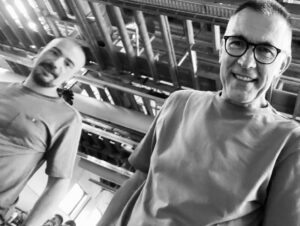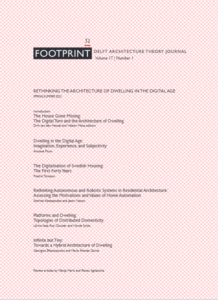
This is not your mainstream journal of architecture. In fact, executive editors Andrej Radman and Stavros Kousoulas say the Footprint – Delft Architecture Theory Journal is meant to be radically different. Bringing together architectural theory and philosophy, they aim to provide a platform that is open and inclusive, sparks interest in the reader, and presents a different take on what education might look like.
Getting philosophical
Established by a group of PhD students in 2007, Footprint was originally intended to help them further their research and connect with other people. At the time, their group at TU Delft’s Faculty of Architecture and the Built Environment was called Architecture Theory, but has since become Architecture, Philosophy, and Theory. Both Assistant Professors within this group, Radman and Kousoulas are educated as architects and are self-described theory people. But they say their passion has driven them towards a more abstract realm of what they believe still belongs to the domain of architecture. “We realised in this kind of postmodern move there is not just one theory, there are many,” says Radman. “We wanted to distinguish ourselves by adding philosophy, which we are both passionate about.” Together with Assistant Professor Aleksandar Staničić, they are guiding Footprint in a unique direction.
Evolution of a journal

Over the years, the journal has evolved through different stages. It started with all the work being done by the people themselves, but has since become a professionalised publication. The team now produces two issues each year, which is no easy task they say. “There is the misconception about journals that it’s all about content or content related discussions,” says Kousoulas. “Of course, these are part of the game, but in order to sustain a rhythm of publications, you need so much more practical work to be put in place.” What now runs like a well-oiled machine has taken a lot of effort on their part and some support when it comes to publishing.
TU Delft OPEN Publishing has been hosting the journal for several years, and last year formally became the publishers of Footprint’s open access online journal. Radman and Kousoulas say the support has been extremely helpful, particularly when it comes to some of the practical aspects of publishing. “Our hearts have always been in open source, so the fact that we have officially joined forces is fantastic,” says Radman. “We believe that academic output should not be behind the paywall as a matter of principle.” The journal also collaborates closely with Jap Sam Books to offer printed issues on demand for people who might still want to have a hard copy in their hands.
Radical inclusivity
With its beginnings as a classical theory architecture journal, Footprint has gradually become more inclusive, making space for different voices. Within their faculty, Kousoulas explains that the architecture department is the biggest group, with lots of people doing lots of different things. “It used to be just the theory people involved in the journal, but it slowly it opened up to other academic groups in this department,” he says. What sets Footprint apart is that every issue is edited by a guest editor, who joins together with one member of the editorial board to propose a topic. “Many other journals have a more curated approach to what they do, so there is a common line that runs precisely throughout all the things that they produce,” says Kousoulas. “What we’re trying to do with Footprint is to allow for the possibility of each one of the people involved in the journal to bring their own interests without compromises. So there are very different topics indeed and every issue is radically different than the next.” As long as Radman and Kousoulas are involved, they say the content will always be as open as possible.
A different way to educate
Embracing the idea of heterogeneity and openness also means reaching students, which is somewhat unique for a journal. “I think sometimes students believe that theory is something that one needs to be fully initiated in before even daring to read an essay,” says Radman. “For us, it is more about the joy of discovering something that may not be fully clear but it might spark a certain interest. So if a single footnote takes you elsewhere, our job is done.” In fact, they don’t expect people to read Footprint from cover to cover. Radman explains that they are happy for people to browse through and find something that catches their eye, maybe taking them to uncharted territory.
With that in mind, they will stay focused on supporting content that is open as possible. “I say this from a pedagogical point of view because it seems as if one way of looking at things is that acquiring knowledge means mastering it and being able to reproduce it,” says Radman. “For us it’s much more interesting to see what it is that people do with what they are – they can chew on some of the things that we provide and then do whatever they want with it. And that is a radically different conception of what teaching, pedagogy, and education might look like.” For now, the team is working to ensure that Footprint is a self-sustainable, resilient machine that keeps evolving and enriching the architecture discipline.
